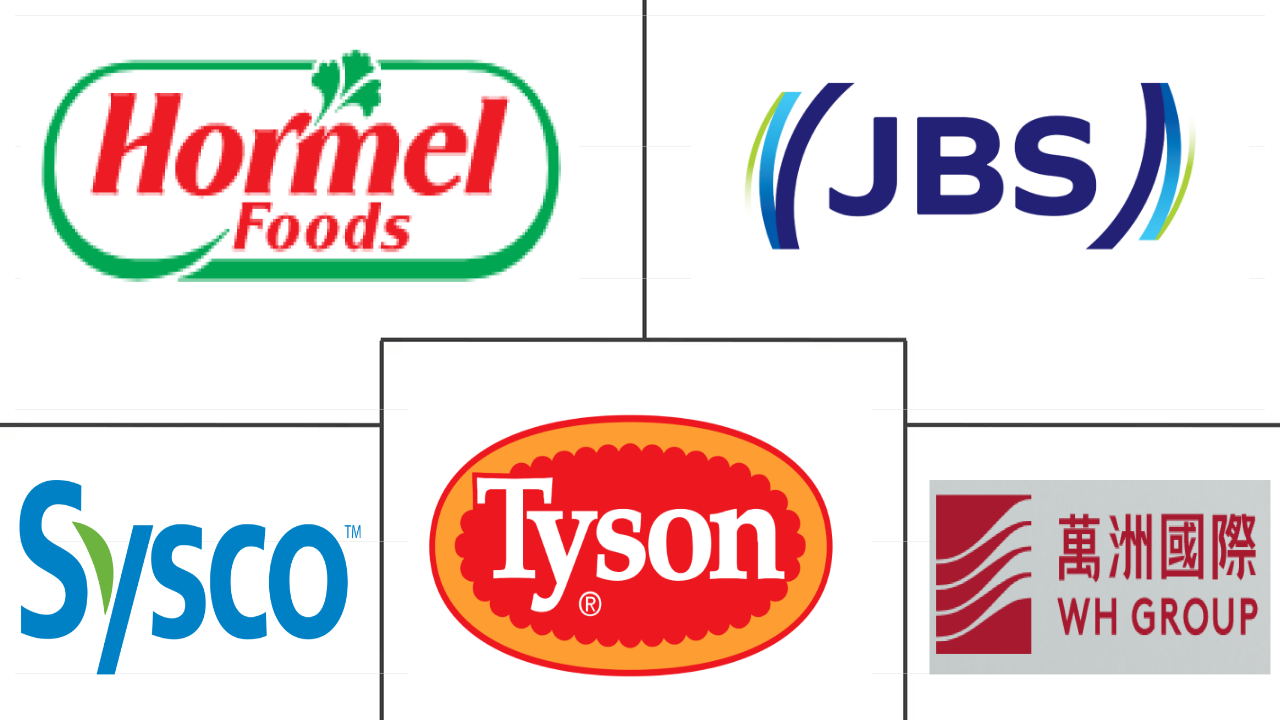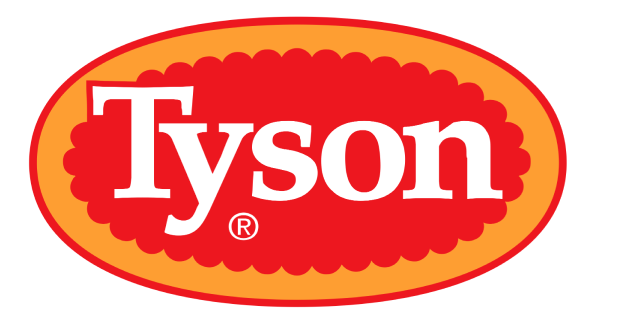Market Size of united states edible meat Industry
| Icons | Lable | Value |
|---|---|---|
|
|
Study Period | 2017 - 2029 |
|
|
Market Size (2024) | USD 134.42 Billion |
|
|
Market Size (2029) | USD 142.85 Billion |
|
|
Largest Share by Type | Beef |
|
|
CAGR (2024 - 2029) | 1.22 % |
|
|
Fastest Growing by Type | Beef |
|
|
Market Concentration | Medium |
Major Players |
||

|
||
|
*Disclaimer: Major Players sorted in no particular order |
United States Edible Meat Market Analysis
The United States Edible Meat Market size is estimated at 134.42 billion USD in 2024, and is expected to reach 142.85 billion USD by 2029, growing at a CAGR of 1.22% during the forecast period (2024-2029).
134.42 Billion
Market Size in 2024 (USD)
142.85 Billion
Market Size in 2029 (USD)
5.53 %
CAGR (2017-2023)
1.22 %
CAGR (2024-2029)
Largest Segment by Type
48.11 %
value share, Beef, 2023
The beef segment is dominated by the fresh/chilled form. However, the prevalence of convenient and healthy eating is driving the demand for processed and grass-fed beef.
Largest Segment by Form
44.02 %
value share, Fresh / Chilled, 2023
The consumers' growing preference for certified fresh foods is driving the demand. Thus, manufacturers offer information on fresh meat to consumers for convenience.
Fastest-growing Segment by Type
1.35 %
Projected CAGR, Beef, 2024-2029
Ground beef, luncheon meat, sausages, hot dogs, salami, pepperoni, burgers and beef jerky are the most popular processed beef products consumed in the United States.
Fastest-growing Segment by Form
2.34 %
Projected CAGR, Processed, 2024-2029
The segment is driven by innovations by new entrants, mainly beef products. Large firms invest in robots and AI start-ups to develop new processing technologies.
Leading Market Player
19.39 %
market share, Tyson Foods Inc., 2022

Tyson dominates the market in the region with its extensive range of product offerings, including almost all types of meat, coupled with brand-conscious consumers.
High production and environmental consciousness are boosting demand for poultry meat
- Poultry is the most consumed meat variant in the country, owing to consumers' inclination toward a leaner animal protein source over red meat variants. The huge consumption rate is due to the versatile usage of poultry meat in various flavors, cooking methods, and recipes, increasing its usage in various food service stations. As of 2021, 8 billion chickens were consumed by Americans. Also, environment-conscious consumers are switching from red meat to poultry options, as intensive chicken farming causes lesser GHG emissions than cattle meat.
- Beef is the country's second most consumed edible meat variety in the United States. As of 2022, annual beef consumption per person was highest in the Midwest (73 pounds), followed by the South and West (65 pounds each) and the Northeast (63 pounds). Rural consumers ate more beef (75 pounds) than did urban and suburban consumers (66 and 63 pounds). Fast food options like beef burgers and hotdogs in the states of the country are also very popular, making beef one of the most consumed and favored meat options. As of 2022, 20 billion burgers with an average of 60 patties per person annually were consumed in the United States, opening opportunities to expand the application of beef.
- Pork is the third-largest type of red market in the country primarily due to the increased consumption of processed pork, such as luncheon meat sausage, hot dogs, ham, and bacon. Thus, processed pork is projected to record the fastest CAGR, amounting to 2.48%, over the forecast period. The growing influence of Asian cuisines, particularly Korean and Vietnamese, has also made some cuts of pork newly popular. Americans are increasingly turning to fast-food restaurants for breakfast, where bacon and pork sausage are both popular.
United States Edible Meat Industry Segmentation
Beef, Mutton, Pork, Poultry are covered as segments by Type. Canned, Fresh / Chilled, Frozen, Processed are covered as segments by Form. Off-Trade, On-Trade are covered as segments by Distribution Channel.
- Poultry is the most consumed meat variant in the country, owing to consumers' inclination toward a leaner animal protein source over red meat variants. The huge consumption rate is due to the versatile usage of poultry meat in various flavors, cooking methods, and recipes, increasing its usage in various food service stations. As of 2021, 8 billion chickens were consumed by Americans. Also, environment-conscious consumers are switching from red meat to poultry options, as intensive chicken farming causes lesser GHG emissions than cattle meat.
- Beef is the country's second most consumed edible meat variety in the United States. As of 2022, annual beef consumption per person was highest in the Midwest (73 pounds), followed by the South and West (65 pounds each) and the Northeast (63 pounds). Rural consumers ate more beef (75 pounds) than did urban and suburban consumers (66 and 63 pounds). Fast food options like beef burgers and hotdogs in the states of the country are also very popular, making beef one of the most consumed and favored meat options. As of 2022, 20 billion burgers with an average of 60 patties per person annually were consumed in the United States, opening opportunities to expand the application of beef.
- Pork is the third-largest type of red market in the country primarily due to the increased consumption of processed pork, such as luncheon meat sausage, hot dogs, ham, and bacon. Thus, processed pork is projected to record the fastest CAGR, amounting to 2.48%, over the forecast period. The growing influence of Asian cuisines, particularly Korean and Vietnamese, has also made some cuts of pork newly popular. Americans are increasingly turning to fast-food restaurants for breakfast, where bacon and pork sausage are both popular.
| Type | |
| Beef | |
| Mutton | |
| Pork | |
| Poultry | |
| Other Meat |
| Form | |
| Canned | |
| Fresh / Chilled | |
| Frozen | |
| Processed |
| Distribution Channel | ||||||
| ||||||
| On-Trade |
United States Edible Meat Market Size Summary
The United States edible meat market is experiencing a steady growth trajectory, driven by consumer preferences and evolving dietary trends. Poultry dominates the market due to its lean protein appeal and versatility in culinary applications, making it a preferred choice over red meat. The shift towards poultry is also influenced by environmental concerns, as chicken farming is associated with lower greenhouse gas emissions compared to cattle farming. Beef remains a significant component of the American diet, particularly in regions like the Midwest, South, and West, where it is a staple in fast food and home-cooked meals. Pork, especially in processed forms such as bacon and sausages, is gaining popularity, partly due to the influence of Asian cuisines. The market is characterized by technological advancements in meat production, which enhance the nutritional value of animal feed and support the industry's growth.
The beef sector, a cornerstone of the US meat industry, is poised for expansion, bolstered by increasing demand from Asian markets. The US leads in beef exports, particularly to countries like China, Japan, and South Korea, despite facing challenges such as supply chain disruptions and fluctuating prices. The beef industry is structured around cow-calf operations and cattle feeding, with significant contributions from states like Ohio, Texas, and Oklahoma. However, environmental factors like droughts have impacted cattle prices and herd sizes, prompting discussions on regulatory interventions to stabilize the market. The industry is moderately consolidated, with major players like Hormel Foods, JBS SA, Sysco Corporation, Tyson Foods, and WH Group Limited dominating the landscape. Recent strategic moves, such as acquisitions and sustainability initiatives, reflect the industry's focus on innovation and long-term growth.
United States Edible Meat Market Size - Table of Contents
-
1. MARKET SEGMENTATION (includes market size in Value in USD, Forecasts up to 2029 and analysis of growth prospects)
-
1.1 Type
-
1.1.1 Beef
-
1.1.2 Mutton
-
1.1.3 Pork
-
1.1.4 Poultry
-
1.1.5 Other Meat
-
-
1.2 Form
-
1.2.1 Canned
-
1.2.2 Fresh / Chilled
-
1.2.3 Frozen
-
1.2.4 Processed
-
-
1.3 Distribution Channel
-
1.3.1 Off-Trade
-
1.3.1.1 Convenience Stores
-
1.3.1.2 Online Channel
-
1.3.1.3 Supermarkets and Hypermarkets
-
1.3.1.4 Others
-
-
1.3.2 On-Trade
-
-
United States Edible Meat Market Size FAQs
How big is the United States Edible Meat Market?
The United States Edible Meat Market size is expected to reach USD 134.42 billion in 2024 and grow at a CAGR of 1.22% to reach USD 142.85 billion by 2029.
What is the current United States Edible Meat Market size?
In 2024, the United States Edible Meat Market size is expected to reach USD 134.42 billion.

